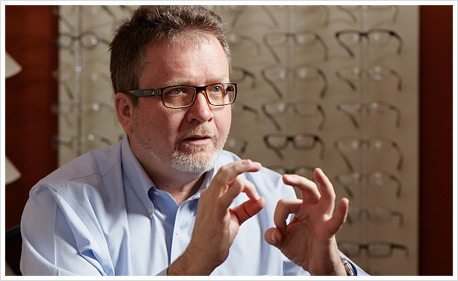Dr. Shaw and the SHAW™ lens

An interview with Dr. Peter Shaw,
developer of the patent-pending SHAW lens.
So, Peter, what led you to developing a lens that solves aniseikonia?
Well, as an optometry student, I was taught how to solve aniseikonia – but the math needed to design the lens was arduous, to say the least. The solution would take hours of math, and even then it was all theoretical since there weren’t any companies around that could make the lens.
So you knew there was a problem – but no solution.
Yes, that’s right. Then, about 15 years ago, I started to look into methods of managing aniseikonia by simplifying the design techniques that I was taught in school. The problem was that even though I could design the lens within existing manufacturing parameters, I STILL couldn’t get labs to make them. And I’ve heard this from some of my colleagues as well – even when they do take the time to do the ray-tracing mathematics for a challenging patient, they simply couldn’t get the lenses made. So I decided to change that.
And that’s when you decided to launch Shaw Lens Inc.?
Yes. I am passionate about optometry and wanted to give my colleagues the resource to solve aniseikonia and simply make more comfortable glasses. (And by comfort, I mean visual comfort.)
So, over the past 10 years, I’ve been refining the design methodology inherent in the SHAW lens system. With digital surfacing technology, we can specify the base curve (the curve of the lens) within a hundredth of a millimetre and specify the thickness within a tenth of a millimetre. And we have the manufacturing partners to deliver on the design.
I’ve heard some optometrists ask if we need to measure the aniseikonia first.
You know, that would be great, but there isn’t an effective eikonometer that’s commercially available. And really, it’s not necessary with our advanced modelling software anyway. With the SHAW lens system, you get a tool that accurately predicts the amount of dynamic and static aniseikonia – that’s the amount of prism generated in off-centre gaze. Now we can design a lens that solves the problems induced by other lens designs.
Can you explain to me how this works?
The SHAW lens design software is pretty sophisticated stuff. It models how your eyes work together and how they sit behind a pair of frames that you’ve selected. And it does all this in three dimensions.
The optometrist has to make a few additional measurements of how your eyes move in relation to each other. He or she uses what’s called a “set of loose prisms” to determine this.
Plus, our SHAW lens design software takes into account your frame dimensions – size, shape and how it fits on your face – and we use all of this information to design a truly binocular (both eyes working together) lens system.
Because the software systematically and accurately predicts the exact effect of lens design on all sorts of eye movement disorders, this is an excellent tool for the optometrist in so many ways.
Sounds like you’re passionate about this!
I’ve been an optometrist for over 30 years – I know, I look younger – and I’ve gotten so much satisfaction out of helping patients see better. I ran a low vision clinic for years, and that really taught me how important it is to use absolutely the best clinical tool for the problem. And that’s what this whole venture of Shaw Lens is about.
So how do I get SHAW lenses?
The first thing to do is find an
optometrist near you who is a SHAW lens practitioner. Alternately, feel free to mention the SHAW lens to your eye care professional. He or she can start prescribing simply by coming to this website.
